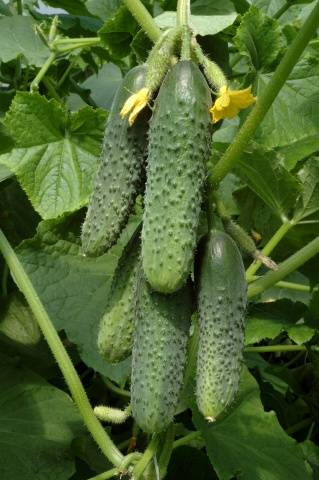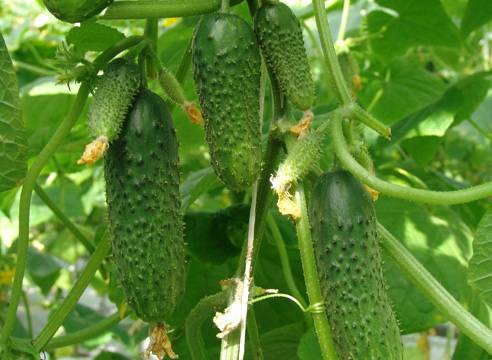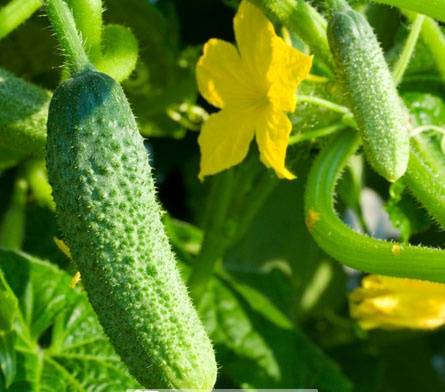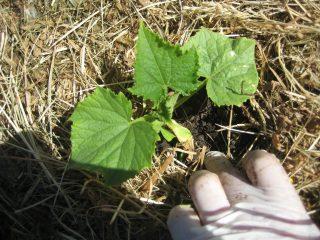Content
- 1 The best varieties of cucumbers grown in greenhouses near Moscow
- 1.1 Variety Zozulya F1
- 1.2 Variety Masha F1
- 1.3 Variety Connie F1
- 1.4 Variety Tumi F1
- 1.5 Variety Courage F1
- 1.6 Variety Murashka F1
- 1.7 Variety Kuzya F1
- 1.8 Variety Claudia F1
- 1.9 Variety Thumb F1
- 1.10 Variety Crispy Pogrebok F1
- 1.11 Variety White Angel F1
- 1.12 Variety Surprise
- 1.13 Variety Babayka F1
- 1.14 Variety Chupa-Shchups F1
Today, a greenhouse on a summer cottage in the Moscow region has gone from exotic to commonplace and increasingly, gardeners are planting plants in greenhouses to obtain early harvests of garden crops. One of these very popular greenhouse crops is cucumbers.
For lovers of fresh and pickled cucumbers who want to grow them in a greenhouse, it is better to choose parthenocarpic hybrids that bear fruit without pollinating insects.
Important qualities for greenhouse cucumbers are disease resistance and shade tolerance.
Varieties for greenhouses are divided into three large groups. The first bears fruit in winter and spring, the second in spring and summer, the third in summer and autumn. First of all, you need to decide whether cucumbers will grow in the greenhouse year-round or only during certain seasons.
Next, you should answer the question: what kind of early maturity is required?
All varieties of cucumbers are quite conventionally divided into three groups:
- early ripening: fruiting less than forty-five days after germination;
- mid-season: from forty to fifty days;
- late ripening; in fifty days.
If the greenhouse is large, you can try to choose varieties so that you always have fresh cucumbers.
The second question that you should answer when going to the store to buy seeds is: what will the cucumbers be used for? There are also three groups: for marinades and pickling, for salads and universal.
Salad cucumbers have thick skin. They are not suitable for pickles. The brine will not be able to penetrate through the thick skin and properly salt the vegetable.
The optimal choice for a small gardener would be universal varieties.
When going to the store to buy seeds, decide on the timing of fruiting and the scope of use of your crop, so as not to get lost in the sea of varieties offered. However, even with a very narrowed choice, your eyes will still wander, and the best varieties for you will have to be chosen experimentally. It is possible to provide some help.
The best varieties of cucumbers grown in greenhouses near Moscow
Everyone has their own definition of “best”. Some people care about yield, some about early ripening, some about taste, some about unpretentiousness. Everyone chooses according to their own criteria.
Variety Zozulya F1
One of the most popular varieties for greenhouses not only in the Moscow region, but throughout the CIS.
Mid-season. From ten to twelve kilograms are removed from a square meter. Being parthenocarpic, it can bear fruit in greenhouses.
An important advantage of the variety is its resistance to diseases that develop in greenhouse conditions. Including ascochyta blight. The seeds of this cucumber can be sown dry, but the soil temperature should be about 28 degrees.It is necessary to monitor optimal humidity and temperature. The disadvantage of Zozuli is the possible bitterness with poor watering.
Variety Masha F1
A relatively new bunched gherkin-type hybrid. Recommended for greenhouses. Early ripening. A fairly open plant, forming up to six ovaries in one bunch, which greatly facilitates harvesting. The variety is universal. Resistant to greenhouse diseases. Seeds are sown in a covered, unheated greenhouse at the rate of four to five seeds per square meter. When growing on trellises, leave two to three plants per square meter. The seed placement depth is one and a half to two centimeters. Watering once every two to three days with exclusively warm water. Fertilizers are applied during watering once every ten days.
Variety Connie F1
Suitable for growing in a greenhouse. It is considered one of the best hybrids in its group. Early ripening high-yielding variety. Average number of lashes with bunched ovaries. Yields up to fourteen kilograms per square meter of greenhouse. Resistant to greenhouse diseases. Seeds are planted in soil that has warmed up to at least fourteen degrees to a depth of three centimeters. Before sowing, the seeds must be soaked.
Watering is done with warm water with regular fertilizing with fertilizers.
Variety Tumi F1
Stable, very early ripening hybrid. Glass and film greenhouses are used for cultivation. Ripens on the fortieth day. Cucumbers are up to 12 cm long and can withstand long-term storage. Resistant to the vast majority of greenhouse diseases.Productivity is up to twenty kilograms per square meter, plant density is three to three and a half bushes per square meter.
Variety Courage F1
Designed for greenhouses. Parthenocarpic. In summer and autumn it bears fruit in a maximum of forty-four days, in winter after fifty-four. Formed into one stem. Beam. There can be two to ten ovaries on one node. Cucumbers are up to 16 centimeters in length and up to 120 grams in weight. Versatile. Retains freshness for up to ten days after collection. Productivity up to twelve kilograms per square meter.
Resistant to greenhouse diseases. Photophilous.
It is necessary to ensure that the leaves do not grow and shade the ovaries. Also, the yield will be lower if planted late, since day length decreases in autumn. To obtain the maximum possible yield, it is necessary to maintain planting density: two plants per square meter. Zelentsy should not be overexposed. With timely harvesting, new ovaries appear. The Kurazh variety is included in the State Register of Russia.
Variety Murashka F1
It does not suffer from powdery mildew and cladosporiosis, but is vulnerable to downy mildew and root rot.
Hybrid for greenhouses and open beds. Included in the state register of the Russian Federation. Parthenocarpic early ripening with a bunch type of ovary formation. There are up to six female flowers on one node.
The bush is formed into one stem, since the variety has an average ability to form lateral shoots. Versatile. With good fruit taste. The length of cucumbers is up to thirteen centimeters, weight up to one hundred grams. You can get twelve kilograms of harvest per square meter. The planting density on trellises is two plants per meter.
Variety Kuzya F1
Parthenocarpic early ripening hybrid bunch type for greenhouses. Zelentsy are short, up to seven centimeters. Bitterness is absent at the genetic level. Versatile. Suitable for pickles, canning and fresh salads. Especially good with Cherry tomatoes.
Variety Claudia F1
Recommended for greenhouses. It has established itself as a reliable variety, capable of producing a good harvest even under unfavorable conditions, since all the flowers are female. Indeterminate. Universal. Cucumbers have a great taste, there is no bitterness. Size up to twelve centimeters, weight up to eighty grams. Fruits in 50 days after germination. You can get up to twenty-seven kilograms per square meter. It is resistant to weather conditions and does not require daily harvesting. For this reason, it is a very good option for summer residents who harvest once a week.
Seeds are sown to a depth of one and a half to two centimeters in heated soil. The bush has the ability to grow well; planting seeds too often is contraindicated. Water with warm water and apply fertilizer once every ten days.
Variety Thumb F1
Bush parthenocarpic hybrid for greenhouses and open beds. High-yielding. Early ripening. Cucumbers up to ten centimeters long. Universal.
The bushes grow strong, with long vines. Do not thicken the plantings; bush hybrids are photophilous. Give the cucumbers enough space to develop.
Variety Crispy Pogrebok F1
I must admit, the name of the variety is quite strange, which is redeemed by its great taste. Designed for greenhouses and open beds. Early ripening, universal. Resistant to greenhouse diseases.
Seeds are sown to a depth of two to three centimeters in soil heated to fourteen degrees. The above varieties have already been time-tested and received the title “best” from professional vegetable growers. But progress does not stand still. Today, perhaps not yet bearing the title of “best,” but certainly exotic varieties are gaining popularity.
Variety White Angel F1
Included in the state register for cultivation in private household greenhouses and small farms. A productive late-ripening hybrid. Cucumbers are white, eight centimeters long. When unripe, they have a greenish tint. The flesh is greener than the skin. When overripe, they acquire a completely white color and a spherical shape. A universal cucumber. They can be preserved well, but the peel is a bit harsh, not for everybody.
Variety Surprise
A heat-loving late-ripening variety that bears fruit one hundred days after germination. Grown in a greenhouse. The vines are long, but the vast majority of the fruits are set in the middle of the vine. The length of the fruit can be up to one meter, but the quality will be significantly worse than that of greens twenty centimeters long. Too soft for preservation, only consumed fresh.
Two more parthenocarpic varieties that are completely new to the Moscow region. Perhaps in a couple of years they will be the ones who will receive the title of “best”. The breeders of these varieties undoubtedly have a sense of humor.
Variety Babayka F1
Breeders promise thin, delicate skin and sweet, crispy flesh from this early-ripening bunch hybrid. The ability to grow side shoots is genetically limited, that is, it does not require the formation of a stem.
The length of greens is up to thirteen centimeters. The variety is universal. Resistant to major diseases. It is frost-resistant, which is important when growing it in unheated greenhouses.
Variety Chupa-Shchups F1
Yes exactly. It got its name from the shape of the fruit. Already included in the state register as recommended for cultivation in greenhouses in private household plots.
The diameter of the fruit is four to five centimeters, weight up to eighty grams. Early ripening, frost-resistant. In a knot of three female flowers. The pulp is sweet and juicy. The variety is universal.
It is recommended to sow seeds immediately into the greenhouse in mid-May.























